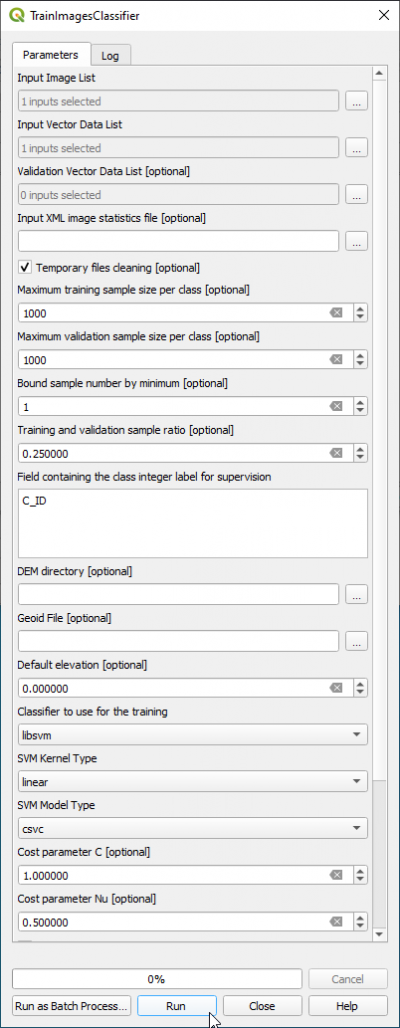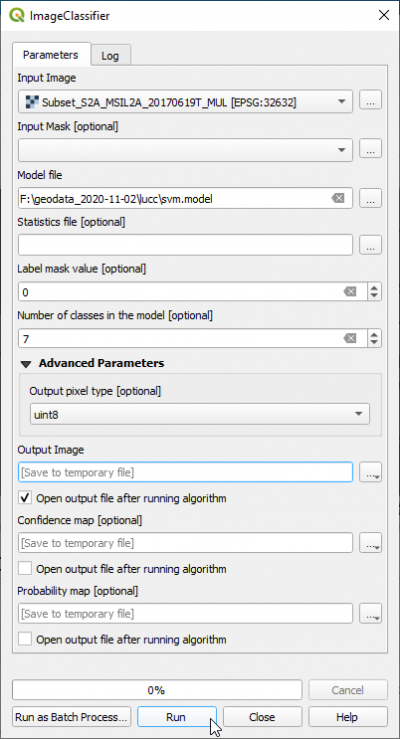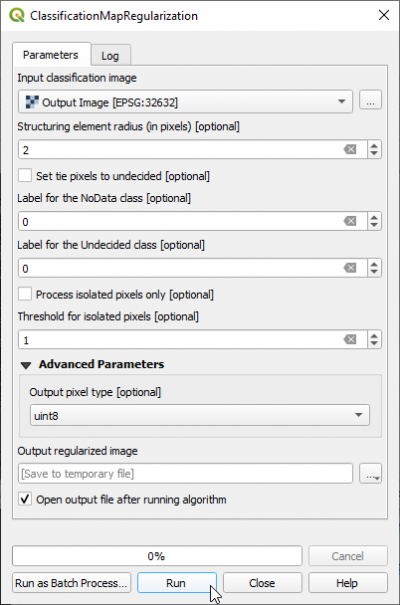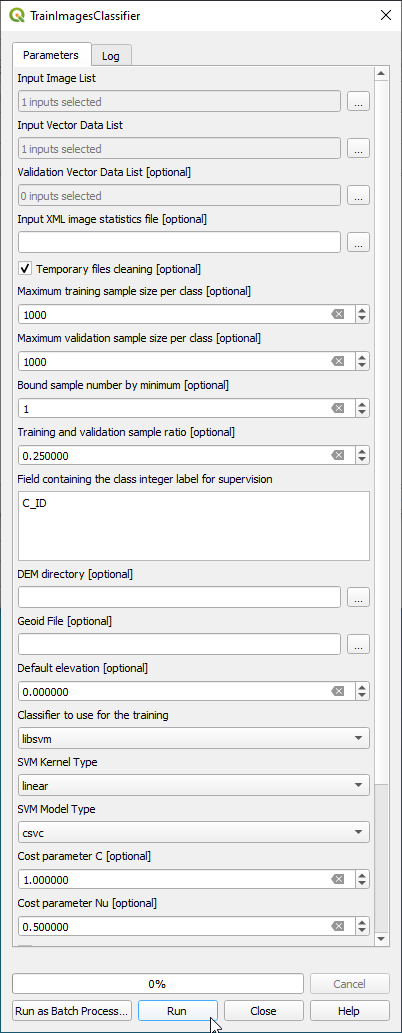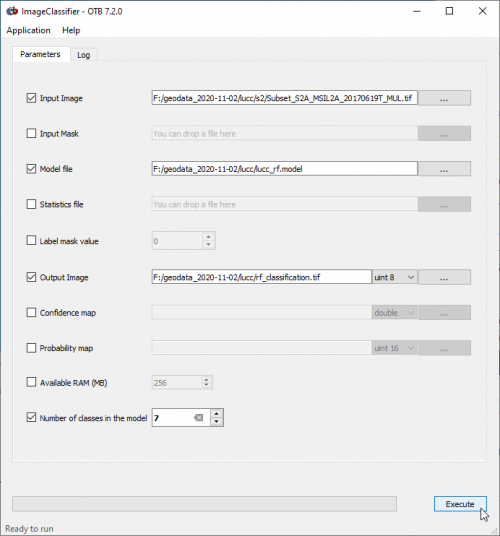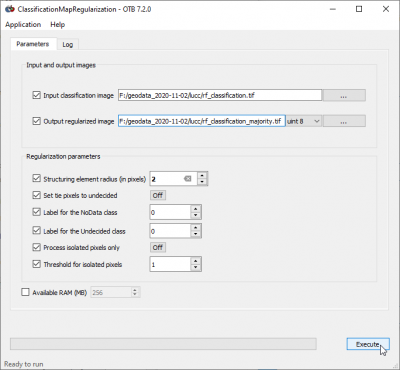Per pixel supervised classification
From AWF-Wiki
(Difference between revisions)
(→Training phase) |
(→Training phase) |
||
| Line 8: | Line 8: | ||
* In the {{button|text=Input Image List}} select one (or optional: several) multi-band raster (multispectral images). | * In the {{button|text=Input Image List}} select one (or optional: several) multi-band raster (multispectral images). | ||
* In the {{button|text=Input Vector Data List}} '''do not''' select a vector file from the list of files which might be already loaded in the QGIS Viewer. There is currently a bug in QGIS 3.16 which leads to failure during file import. Instead please select a vector file clicking [[File:Qgis_add_file.png]] and browse directly to the file containing training area polygons in format GPKG or SHP. | * In the {{button|text=Input Vector Data List}} '''do not''' select a vector file from the list of files which might be already loaded in the QGIS Viewer. There is currently a bug in QGIS 3.16 which leads to failure during file import. Instead please select a vector file clicking [[File:Qgis_add_file.png]] and browse directly to the file containing training area polygons in format GPKG or SHP. | ||
| − | * | + | * If you do not have independent validation data: leave {{button|text=Validation Vector Data List}} empty. |
| − | * Bound sample number | + | * Bound sample number ba minimum: {{typed|text=1}}. The class with the minimum number of pixels determines the sample size of all other classes. Changing this value to {{typed|text=0}} does not have an effect (current bug in QGIS3.16). |
* Training and validation sample ratio: {{typed|text=0.25}}. This is a 4-fold cross-validation with split 0.75 per cent for training and 0.25 per cent for testing. | * Training and validation sample ratio: {{typed|text=0.25}}. This is a 4-fold cross-validation with split 0.75 per cent for training and 0.25 per cent for testing. | ||
| − | * Type {{typed|text=C_ID}} in the {{button|text=Field | + | * Type {{typed|text=C_ID}} in the {{button|text=Field containing the class integer label for supervision}} text field. |
| − | * | + | * As Classifier to use for training choose Support Vector Machine {{button|text=libsvm}} from the drop down list. |
| − | + | ||
* The SVM Kernel Type is {{button|text=Linear}}. | * The SVM Kernel Type is {{button|text=Linear}}. | ||
| + | * SVM Model Type is {{button|text=csvc}} | ||
* Switch checkbox {{button|text=Parameters optimization}} '''off'''. The optimization results in a higher accuracy but takes much time (> 1 hour computation). | * Switch checkbox {{button|text=Parameters optimization}} '''off'''. The optimization results in a higher accuracy but takes much time (> 1 hour computation). | ||
| − | * In the {{button|text=Output model}} specify | + | * In the {{button|text=Output model}} specify a model file: e.g. '''svm.model''' |
* Click {{button|text=Run}}. | * Click {{button|text=Run}}. | ||
* Click on the {{button|text=Log}} tab and inspect the '''model quality''' measures: Precision, Recall, F-score and Kappa index. | * Click on the {{button|text=Log}} tab and inspect the '''model quality''' measures: Precision, Recall, F-score and Kappa index. | ||
Revision as of 23:03, 12 December 2020
Contents |
Using QGIS and OTB processing toolbox
- Using OTB version 7.2.0, input vector file format of training data can be GeoPackage GPKG or ESRI Shapefile.
- The column containing class label needs to be an integer (whole number).
Training phase
- In the search engine of Processing Toolbox, type TrainImages and open TrainImagesClassifer.
- In the Input Image List select one (or optional: several) multi-band raster (multispectral images).
- In the Input Vector Data List do not select a vector file from the list of files which might be already loaded in the QGIS Viewer. There is currently a bug in QGIS 3.16 which leads to failure during file import. Instead please select a vector file clicking
 and browse directly to the file containing training area polygons in format GPKG or SHP.
and browse directly to the file containing training area polygons in format GPKG or SHP.
- If you do not have independent validation data: leave Validation Vector Data List empty.
- Bound sample number ba minimum: 1. The class with the minimum number of pixels determines the sample size of all other classes. Changing this value to 0 does not have an effect (current bug in QGIS3.16).
- Training and validation sample ratio: 0.25. This is a 4-fold cross-validation with split 0.75 per cent for training and 0.25 per cent for testing.
- Type C_ID in the Field containing the class integer label for supervision text field.
- As Classifier to use for training choose Support Vector Machine libsvm from the drop down list.
- The SVM Kernel Type is Linear.
- SVM Model Type is csvc
- Switch checkbox Parameters optimization off. The optimization results in a higher accuracy but takes much time (> 1 hour computation).
- In the Output model specify a model file: e.g. svm.model
- Click Run.
- Click on the Log tab and inspect the model quality measures: Precision, Recall, F-score and Kappa index.
Classification phase
- In the search engine of Processing Toolbox, type ImageClassifier and double click ImageClassifier.
- Set an multiband image as Input image.
- Set Input _mask to blank (top of drop-down list).
- Set svm.model as Model file.
- Set the number of classes in your model: this is the number of unique classes in your training file.
- Set Output pixel type to uint8
- Save the Output image as svm_classification.tif.
- Uncheck Confidence map: Open output file after running algorithm.
- Uncheck Probability map: Open output file after running algorithm.
- Add svm_classification.tif to QGIS canvas.
- Find the prepared style file classified.qml.
- Right click svm_classification.tif in the TOC and select Properties --> Symbology --> Style --> Load Style.
- Select the style file classified.qml. OK.
Postprocessing
This application uses a majority filter with a circular structure element.
- In the search engine of Processing Toolbox, type regularization and double click ClassificationMapRegularization.
- Define Input classification image as an classification output raster.
- Set Structuring element radius to 2 pixels.
- Set Output pixel type to uint8.
- Save the Output regularizd image as svm_classification_majority.tif.
- Click Run.
Using OTB standalone
Training phase
- Type into the search box of the Windows taskbar: mapla.bat. Click on mapla.bat to open Monteverdi Application Launcher.
- In the search engine of mapla, type TrainImages and double click TrainImagesClassifer.
- In the Input Image List click on + and select a (or optional: several) multispectral images: Subset_S2A_MSIL2A_20170619T_MUL.tif .
- In the Input Vector Data List choose a vector polygon file with training areas in file format GPKG or SHP.
- In the Output model specify an output model file: e.g. lucc_svm.model
- Activate the checkbox and save the Output confusion matrix or contingency table as lucc_svm_confusion.csv.
- In the Bound sample number by minimum field type 0.
- Set the training and validation sample ratio to 0. (0 = all training data).
- Mark C_ID in the Field containing the class integer label (C_ID refers to the column that contains the LUC code in the training and validation vector file).
- Choose LibSVM classifier from the drop down list as Classifier to use for the training.
- The SVM Kernel Type is Linear.
- The SVM Model Type is C support vector classification.
- Switch the Parameters optimization to on.
- Check user defined seed and enter an integer value.
- Click on Execute.
- Click on the Log tab and inspect the quality measures: Precision, Recall, F-score and Kappa index.
Classification phase
- In the search engine of mapla, type ImageClassifier and double click ClassifcationMapRegularization
- Set Subset_S2A_MSIL2A_20170619T_MUL.tif as Input image.
- Set SVM.model as Model file.
- Save the Output image as svm_classification.tif.
- Evaluate classification results:
- Add svm_classification.tif to QGIS canvas.
- Download the style file classified.qml from Stud.IP.
- Right click svm_classification.tif in the TOC and select Properties --> Style --> Style --> Load Style.
- Select the style file classified.qml. OK.
Postprocessing
This application uses a majority with a circular structure element.
- In the search engine of mapla, type, regular and double click ClassifcationMapRegularization.
- Define Input classification image as ans classification output raster.
- Save the Output regularizd image as svm_classification_majority.tif.
- Set Structuring element radius to 2 pixels.
- Set Output pixel type to uint8.
- Click Execute.
